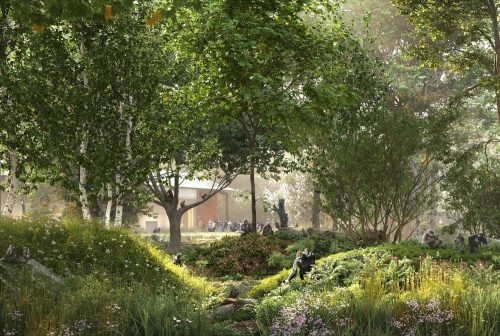Ambitious zoo project gets green light from planners

A project which will see the African forest recreated in the heart of the South West has been granted planning permission.
Grant Associates and Feilden Clegg Bradley Studios have worked with conservation and education charity Bristol Zoological Society to secure planning approval for the new Central African Forest habitat at its Bristol Zoo Project site.
Western lowland gorillas and cherry-crowned mangabeys are to live together for the first time in a UK zoo, as part of ambitious plans to conserve and protect some of the world’s most threatened species.
Work will begin this spring and see the zoo’s existing gorilla troop joined by a new group of mangabeys, as well as Critically Endangered slender-snouted crocodiles, Endangered African grey parrots and several extremely threatened species of West African freshwater fish.
The development is a major step forward in the Society’s plan to create a new, cutting-edge conservation zoo, where at least 80 percent of species will be connected to its conservation work in the UK and around the world.
The gorillas and mangabeys will be living in an area four and a half times the size of the gorilla troop’s current home at the former Bristol Zoo Gardens.
Central African Forest will make the most of the wooded area of the zoo’s 136-acre site in South Gloucestershire. It has been designed to evoke a sense of the dense forest and landscape of Equatorial Guinea, where the Society runs one of its largest conservation projects focused on gorillas and other threatened forest species.
Like the attraction’s award-winning Bear Wood, the new habitat will have integrated learning spaces, enabling students, visitors and schoolchildren to observe, record and appreciate animals in a natural scene, connecting people to threatened wildlife and animals in an immersive landscape.
Landscape architect Grant Associates has been responsible for leading the design of the overall habitat and siting of viewing spaces.
Feilden Clegg Bradley Studios has designed the buildings to blend seamlessly into the landscape and provide rich educational spaces for visitors.
James Clarke, senior associate at Grant Associates, said: “Our challenge has been to create a world class conservation habitat that provides a stimulating and healthy living environment for these threatened species.
“Leading a great team, we have worked to carefully deliver a design that meets the needs of the gorillas and mangabeys, whilst balancing numerous technical constraints to preserve the character of this historic South Gloucestershire setting and retain as many high quality and long-established trees as possible. Careful consideration has been given to every element of the habitat’s design, from the siting of the gorilla and crocodile houses, to the moat and viewing spaces whilst offering visitors a rare glimpse into the lives of these fascinating yet critically endangered creatures.”
Marcus Rothnie, partner at Feilden Clegg Bradley Studios, added: “Bristol Zoo Project will be an immersive landscape-led conservation zoological experience for visitors. The animals will have generously-scaled spaces that reflect their native environments, adopting world-class animal management design standards.
“We have designed the buildings as a series of tidy, quiet volumes sitting within the existing woodland, framing and enabling an exciting landscape-centred visitor experience. This marks the first stage of our innovative emerging proposals for Bristol Zoological Society, designed from the ground up around educating and connecting people with global conservation work and encouraging sustainable behaviours through a great day out.”
Justin Morris, Chief Executive, Bristol Zoological Society, said “We are thrilled to have secured planning permission for this new habitat, which is a major step forward in our vision to create a modern conservation zoo with animals living in spaces more closely reflecting their natural habitats.
“Creating a new environment such as this helps to raise vital awareness of the risks these species are facing and the efforts we can all take to Save Wildlife Together. Work on the new habitat will begin in the spring and is expected to be complete next year.
“In the future we will also be building new visitor facilities and a conservation campus for students studying to become conservationists. This is a really exciting time not only for the zoo, but also for our visitors, partners and supporters. Conservation zoos have a critical role to play in working with communities and connecting them with wildlife.”
As well as the upcoming works, there are also plans for a Central African Savannah habitat, which will see black rhinos and ostriches join giraffe, zebra and cheetah, as well as improvements to the existing Walled Garden, including the creation of new aviaries.
Bristol Zoo Project, which is located near Junction 17 of the M5, will remain open throughout the development work. The attraction is already home to animals from around the world including giraffes, cheetahs, zebras, wolves, bears, lynx, deer, ostrich, gelada baboons and lemurs.









